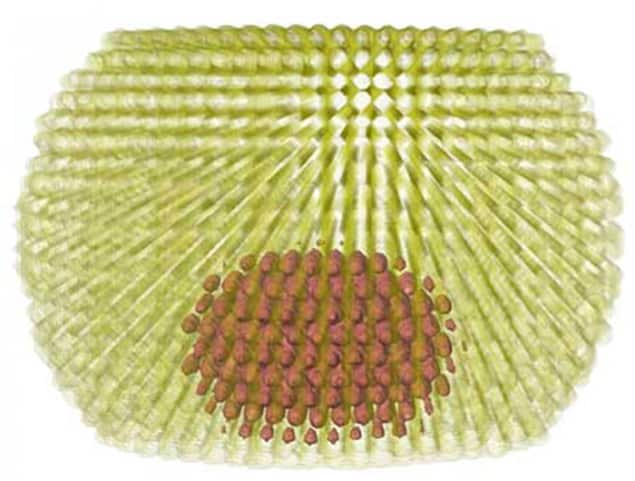
Quantum dots have revolutionized the field of optoelectronics due to their atom-like electronic structure. However, the prospect of colloidal quantum-dot lasers has long been deemed impractical due to the high energies required to induce optical gain. But recent work published in Nature and led by Ted Sargent of the University of Toronto shows that the lasing threshold in cadmium selenide (CdSe)/cadmium sulphide (CdS) core-shell colloidal quantum dots can be lowered by squashing the CdSe core via a clever ligand exchange process.
To instigate optical gain in a semiconductor laser, the difference between the lowest electron level and the highest hole level must be wider than the band gap so that the light emitted when they recombine can stimulate emission in neighbouring nanocrystals. Colloidal quantum dots (CQDs) then, should make ideal candidates for lasing applications, as their atom-like electronic structure means that the electron and hole energy levels are easier to separate.
In practice, however, the energies required to trigger optical gain in CQDs are so high that they can heat up to the point of burning. While electrons tend to occupy one energy state upon excitation, the hole that they leave behind in the valence band can populate one of eight closely spaced states. This degeneracy pushes the hole Fermi level into the band gap and increases the amount of energy required to instigate optical gain.
To overcome this issue, the researchers took advantage of the fact that CdS imposes a strain on CdSe due to a slight lattice mismatch of 3.9%. By growing an asymmetric CdS shell around a “squashed” oblate CdSe core, they were able to induce a biaxial strain that affected the heavy and light holes of the valence band to different extents, thus lifting the degeneracy.
To produce these asymmetric CQDs the group invented a technique called facet-selective epitaxy, making use of ligands that interact differently with the surfaces of CdSe. One of these ligands, trioctylphosphine sulphide, or TOPS, binds weakly to the (0001) facet of CdSe and not at all to the (0001), while octanethiol interacts similarly with all CdSe surfaces. Therefore, by growing CdS on the (0001) facet with TOPS and then replacing with octanethiol to stimulate epitaxial growth, oblate-shaped CQDs could be made throughout the entire particle ensemble with remarkable uniformity.
The resulting lasers had an unprecedentedly high performance, exhibiting a low lasing threshold of 6.4–8.4 kW cm–2, a seven-fold reduction compared with previous attempts. They also emitted light over a narrow energy range of just 36 meV. Both of these properties can be attributed to the enhanced splitting of the valence band levels that arises due to the oblate CQD shape.
The international team of researchers has certainly proved that continuous-wave CQD lasers are possible, yet there are still some obstacles to be overcome before they are seen on the market. Most importantly, the next step will be exciting the CQDs via electrical rather than optical means, as in standard commercial lasers. Nevertheless, facet-selective epitaxy opens up a whole host of other CQD materials for lasing applications and beyond.



